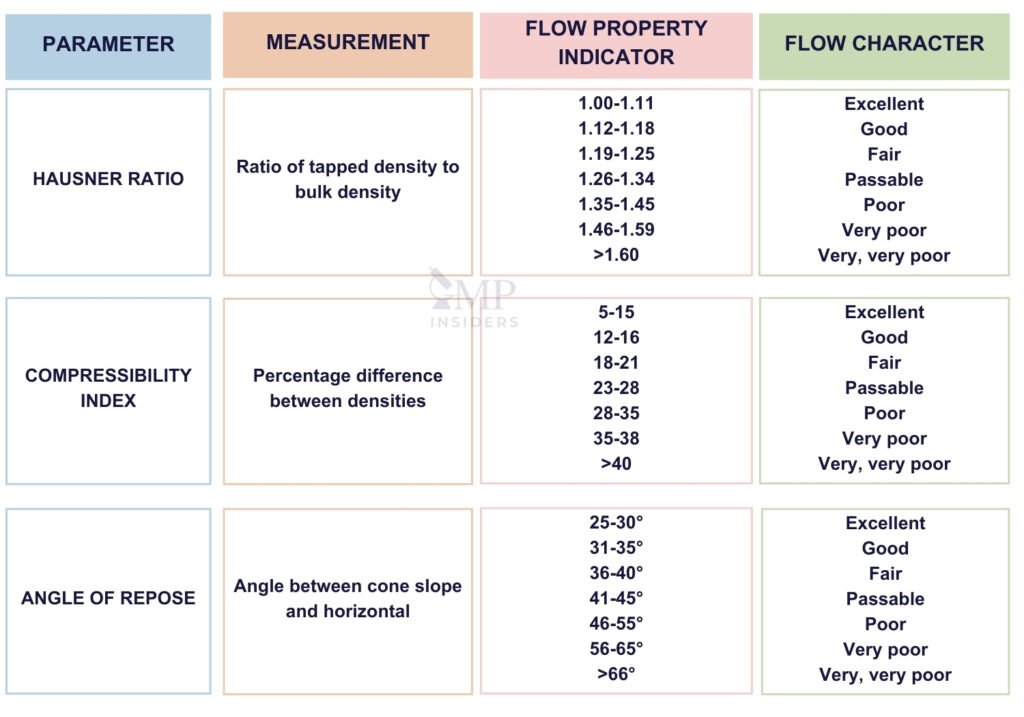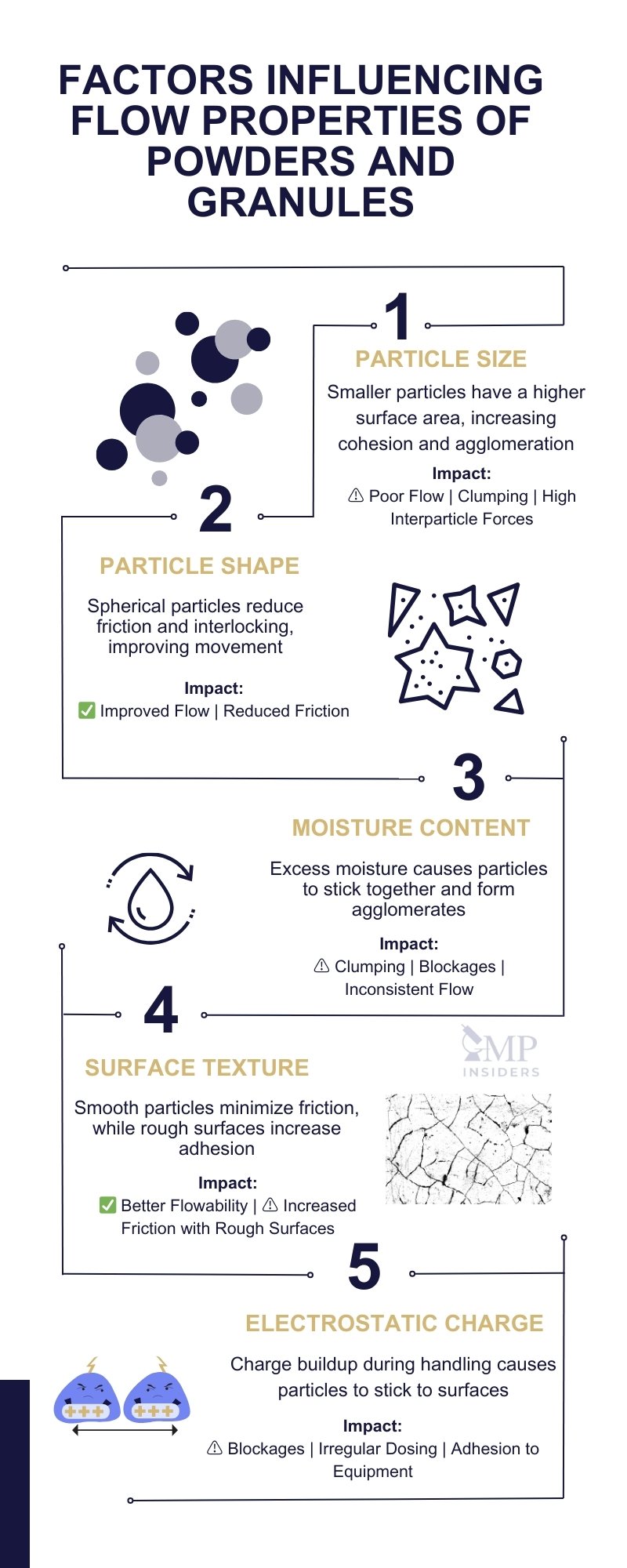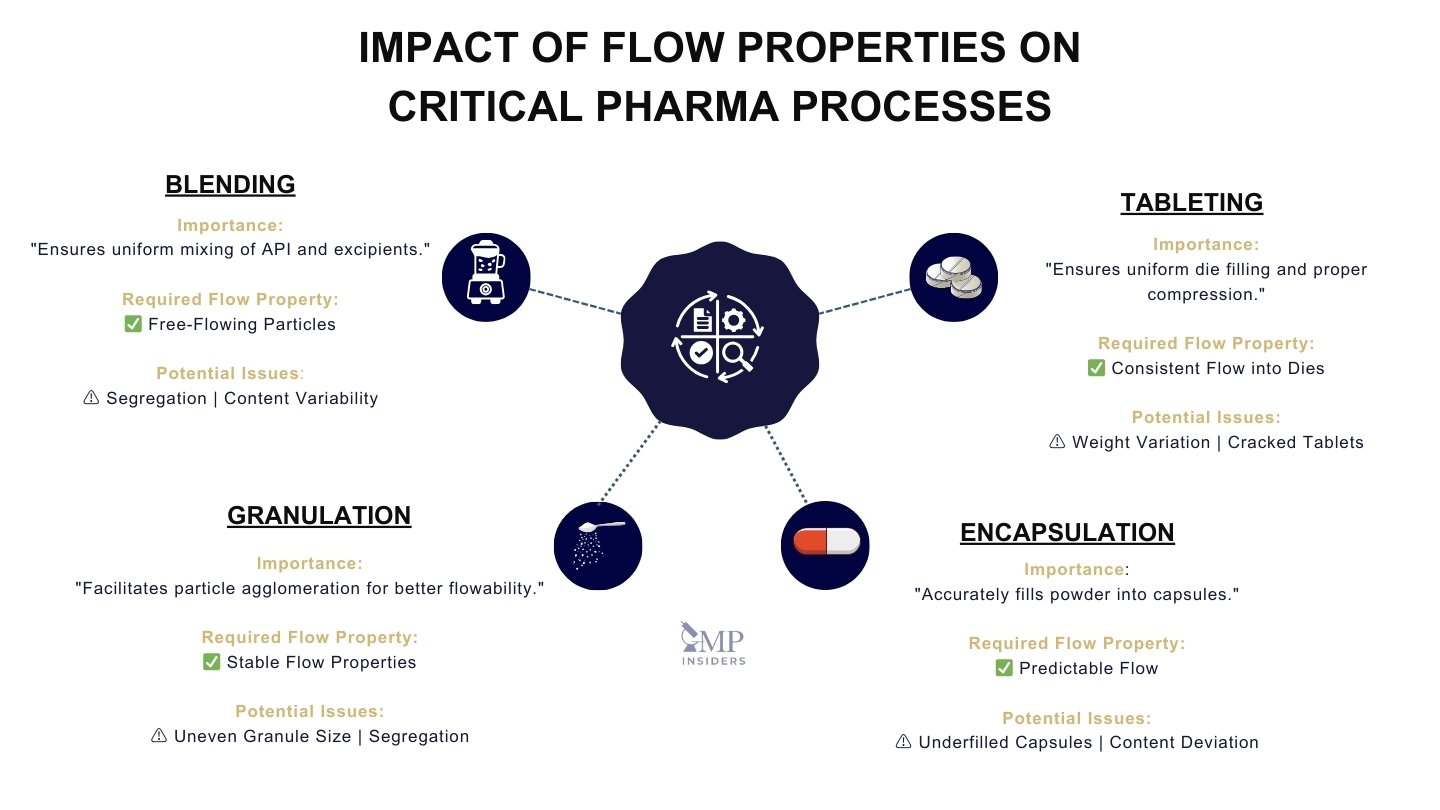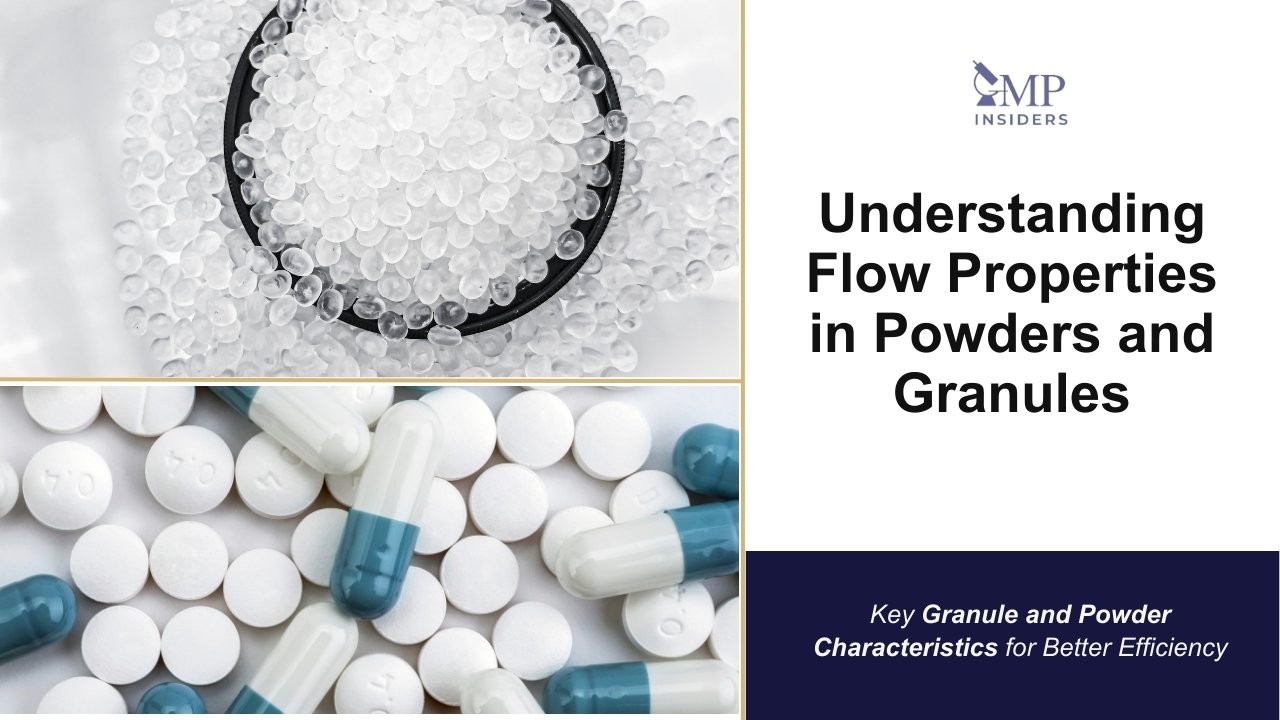Flow properties of powders and granules refer to the characteristics that determine how these materials behave under the influence of external forces such as gravity, vibration, and applied pressure. Key parameters defining these properties include the angle of repose, which indicates how easily a powder piles up or spreads, and bulk and tapped densities, which provide insight into how efficiently the particles pack together.
This article will explore the flow properties of powders and granules, examining key factors like particle size, shape, and moisture content, as well as metrics such as the angle of repose and the Compressibility Index that influence flowability.
Flow Behavior of Powders and Granules in Production
Measures like the Compressibility Index and Hausner Ratio are also critical in evaluating flowability and predicting issues related to compaction or segregation. These properties influence particle size and distribution, shape, surface texture, and moisture content.
The flow behavior of powders and granules in pharmaceutical manufacturing is critical for maintaining consistency and efficiency throughout various production stages. Powder materials, from active pharmaceutical ingredients (APIs) to excipients, must exhibit predictable flow properties to ensure uniform mixing, precise filling, and accurate dosing in tablets and capsules.
Similarly, granules often produced through wet or dry granulation techniques to improve flowability must maintain stable flow characteristics to prevent issues such as ingredient segregation, machinery clogging, or inconsistent dosage units. These problems can directly impact product quality and compliance with regulatory standards.
Inconsistent flow of powders and granules poses multiple risks, including weight variations, content non-uniformity, and potential batch rejection. These issues may lead to regulatory non-compliance, costly product recalls, and financial losses.
Additionally, flow behavior heavily influences production scalability: processes optimized for small-scale R&D may only seamlessly transition to large-scale manufacturing by addressing flow variability.
Materials must move efficiently between equipment without clogging or segregating in critical operations such as blending, compression, granulation, and encapsulation. Consistent flow into dies is essential to achieving uniform tablet weight and hardness during tablet compression. Any disruptions at this stage, such as poor flow leading to cracked tablets or underfilled capsules, can render products unusable. Thus, understanding and mastering the flow properties of powders and granules is vital to ensuring both product quality and process efficiency.
SEE ALSO: Powders, Granules, and Tablets: What is the Difference
Key Concepts and Parameters in Powder and Granules Flow
The Carr Compressibility Index and Hausner Ratio are critical metrics used to evaluate the compressibility potential of powders and granules. These metrics reflect the significance of interparticle interactions in influencing flow behavior. These interactions are minimal in free-flowing powders and granules, leading to only slight differences between bulk and tapped densities.
However, the interparticle forces are more pronounced when dealing with materials with poor flow properties, causing a significant difference between these densities. This variation can be crucial for understanding the flowability challenges encountered during manufacturing processes such as compression, blending, or encapsulation.
Hausner Ratio
The Hausner Ratio specifically measures the tendency of powders and granules to consolidate under mechanical force. It is calculated as the ratio of tapped density (density after repeated tapping) to bulk density (initial, loose density). Values above 1.25 generally indicate poor flowability, meaning the material is more likely to clump or resist flow, whereas ratios below 1.25 suggest better flow characteristics. The formula is expressed as:
Hausner ratio = Vo / Vf
Compressibility Index (Carr Index)
The Carr Index represents how easily a powder or granule compacts when subjected to mechanical force. It is calculated as a percentage difference between bulk and tapped densities and provides insight into the potential difficulties in achieving uniform flow and compaction. A higher Carr Index (above 25%) indicates poor flowability, while values below 15% are associated with good flow. The formula is given as:
Compressibility Index= 100(Vo-Vf)/Vo
Where:
Vo – unsettled apparent volume
Vf – final tapped volume
This metric is widely used in the pharmaceutical industry because it highlights possible flow and compaction issues during processes like tableting and capsule filling.
Angle of Repose
The angle of repose offers a visual representation of how a powder or granule flows. When a material is poured to form a cone, the angle between the slope of the cone and the horizontal surface reflects flowability. Lower angles (less than 30°) are associated with good flow properties, indicating low interparticle friction, while higher angles suggest poor flow behavior. The angle is calculated using the formula:
\( \theta = \arctan\left(\frac{h}{r}\right) \)
Where:
θ: Angle of Repose, representing the angle between the surface of a cone-shaped pile and the horizontal ground.
h: Height of the powder cone.
r: Radius of the base of the cone.

- Static Angle of Repose: Measured when the powder is at rest, this offers a baseline assessment.
- Dynamic Angle of Repose: Measured during powder movement, such as in rotating drums or flowing down chutes, it provides a more realistic understanding of flow behavior under production conditions.
Powder and granule flow behavior is also influenced by the flow regime encountered during storage and transfer, significantly affecting product consistency and manufacturing reliability. The two primary flow regimes are:
Mass Flow occurs when all particles move simultaneously through a hopper or feeder, adhering to a “first-in, first-out” principle. This ensures that the entire bulk material flows cohesively, minimizing the risk of ingredient segregation and maintaining uniform composition.
Mass flow systems have fewer dead zones where material can become stagnant, which is particularly beneficial for pharmaceutical applications where consistent blending and accurate dosing are critical.
Funnel Flow, on the other hand, is characterized by the movement of only the central portion of the powder, while material along the hopper walls remains stagnant. This can lead to several issues, including ingredient segregation, non-uniform dosing, and the potential formation of rat holes or stable arches that may obstruct the flow.
In pharmaceutical manufacturing, funnel flow is generally undesirable because it compromises product homogeneity and dosing precision, increasing the likelihood of quality inconsistencies and regulatory non-compliance.
Flow Characterization Techniques
It’s essential to utilize both static and dynamic methods to grasp the flow characteristics of powders and granules since each reveals distinct behaviors under different conditions. Merging these methodologies gives manufacturers accurate insights into flow performance, allowing them to enhance processes and effectively tackle possible flow issues.
Static Methods
Compressibility Index and Hausner Ratio: These metrics are derived from measuring powders and granules’ bulk and tapped densities. They offer a straightforward and rapid assessment of a material’s behavior during processes like compression or encapsulation.
While these tests are practical and easy to conduct, they primarily reflect the powder’s tendency to compact and do not account for its behavior in dynamic, flowing conditions. Therefore, they are often used as initial indicators but should be complemented with more dynamic evaluations.
Shear Cell Testing: The Jenike shear cell test is a widely used method for evaluating the behavior of powders under stress, such as during storage in hoppers or silos. This test measures critical parameters like cohesion, internal friction, and shear strength.
It is particularly valuable for predicting flow stoppages or blockages in bulk handling systems, especially when dealing with cohesive powders, such as fine or moist granules. By understanding these stress-induced properties, manufacturers can design equipment and processes that minimize flow disruptions.
Dynamic Methods
Angle of Repose Measurements: The dynamic angle of repose provides insight into how powders and granules behave during continuous operations. Unlike static measurements, the dynamic angle is assessed as powder flow or as being in motion, better simulating real-world conditions. Powders with a lower dynamic angle are generally more suitable for high-speed tableting or filling processes, as they ensure consistent and reliable flow into dies or feeders.
Flow-Through Orifice Tests: These tests simulate how powders behave when moving through narrow openings, such as those found in feeders, dies, or discharge outlets. By observing continuous or intermittent flow patterns, manufacturers can identify potential flow disruptions, such as bridging, rat-holing, or pulsating discharge, that could interfere with production. Addressing these issues in advance helps improve process efficiency and prevent costly downtimes.
Additionally, powder rheometers have emerged as an advanced method for analyzing powder flow. These instruments provide a more comprehensive assessment by measuring the force-displacement relationship as a blade or probe moves through a powder bed.
Powder rheometry can help predict how particulate systems will respond to different processing conditions, such as changes in speed, pressure, or environmental factors. This offers valuable insights for optimizing manufacturing operations.
Limitations
Powder flow characterization methods are essential for understanding material handling, but each comes with limitations that can affect the accuracy, reproducibility, and practical relevance of the data obtained.
Reproducibility Issues
One significant challenge is the reproducibility of results. Many flow characterization methods, such as angle of repose and flow through orifice tests, are sensitive to minor changes in testing conditions, such as vibration, humidity, and particle size.
These factors can cause variability in results and make it challenging to reproduce findings consistently. Additionally, some tests, like the angle of repose, can be highly dependent on the operator’s handling, such as how the powder is poured, which can introduce further inconsistencies.
Shear cell tests are particularly challenging to reproduce with powders that exhibit elastic or plastic properties, as even slight differences in test conditions can alter the powder’s response.
Influence of Performance Conditions
Environmental factors, including temperature and humidity, often impact powder flowability. A powder tested in one environment may behave differently in another, leading to a mismatch between laboratory results and real-world behavior.
Additionally, tests like angle of repose are influenced by performance-specific conditions such as the funnel’s shape and size, how the powder is handled, and even the testing room’s atmosphere, all of which can produce inconsistent results.
Predictability Limitations
Static methods, including bulk and tapped density measurements, provide only limited insights into powder behavior. They are semi-quantitative and may not accurately predict how the powder will perform in dynamic settings, such as high-speed mixing or tablet compression.
Highly cohesive powders, for instance, often pose challenges for angle of repose testing, as they may clump together or stick to the funnel, preventing them from flowing freely and skewing the results. To mitigate this, vibration may be introduced to help the powder flow, but this can further distort measurements. Complex behaviors in certain powders, like agglomeration or static buildup, are also challenging to capture with standard tests.
Time Consumption and Practicality
Time consumption and practicality are also issues, especially for tests like shear cell analysis, which requires considerable setup and calibration, making it impractical for high-throughput environments where rapid data is needed. Shear tests also involve labor-intensive processes, requiring multiple measurements across several points, which may be inefficient for industries needing fast, reliable information.
Challenges with Cohesive and Elastic Powders
Highly cohesive powders, which tend to clump or bridge over narrow openings, present additional challenges in flow characterization tests. These powders may not flow freely in the angle of repose measurements, leading to inaccurate readings. Elastic powders also pose challenges, as their tendency to deform and revert to their original shape complicates tests that assume a more rigid particle structure, such as shear cell tests.
Instrumentation and Technique Limitations
Some methods are inherently limited by their design. Bulk and tapped density tests, for example, provide semi-quantitative insights that may not fully represent how a powder will behave under processing conditions, making them unreliable if used alone. The angle of repose measurements offers a basic, qualitative flow assessment but may lack the precision needed for more demanding applications.
Factors Influencing Powder and Granules Flowability

Understanding the factors that influence the flowability of powders and granules is crucial for optimizing their performance in manufacturing and ensuring consistent product quality.
Material Properties
Some of the most important factors influencing the material properties of powders and granules include:
Particle Size and Shape
Particle size and particle size distribution are critical factors that influence flowability and other properties, such as bulk density, angle of repose, and compressibility of bulk solids.
These attributes are critical when working with powders and granules in manufacturing processes. Even minor changes in particle size can lead to significant variations in flowability, which can impact processing efficiency and the quality of the final product.
Reducing particle size generally decreases the flowability of granular materials due to the increased surface area per unit mass. The finer the particles, the greater the contact area between them, which enhances cohesive forces and makes the material more likely to agglomerate.
This increased cohesiveness diminishes flowability, making powders and granules with a wide or fine particle size distribution more challenging to handle. Furthermore, finer particles and irregular shapes increase inter-particle friction, exacerbating flow difficulties.
In contrast, larger and more spherical particles tend to flow more easily, with less interlocking and reduced frictional resistance. Therefore, understanding and carefully controlling particle size and distribution is essential in optimizing material flow and achieving reliable, consistent performance in processes like blending, compression, and tableting.
Surface Morphology
Smooth surfaces reduce particle adhesion and enhance flowability, while rough surfaces increase cohesion, potentially leading to blockages.
Moisture Content
The physical structure and chemical composition of dry powders and granules significantly affect their ability to absorb moisture from the surrounding environment, a characteristic known as hygroscopicity. Hygroscopicity refers to the extent to which a material can uptake water from ambient humidity, and this property can vary widely based on the material’s surface area, porosity, and chemical affinity for water.
Granules, like powders, can exhibit varying degrees of hygroscopic behavior depending on how they are formulated and processed.
When powders or granules absorb excessive moisture, they may clump together, forming agglomerates that obstruct flow and interfere with processing steps such as mixing, conveying, and filling. This can lead to equipment blockages and inconsistent dosing, compromising product quality and manufacturing efficiency.
In highly controlled environments, measures such as drying materials to reduce moisture content or incorporating desiccants in packaging are often necessary to mitigate these issues. Additionally, granulation processes are sometimes designed to enhance the moisture resistance of materials, improving their stability in humid conditions and reducing the risk of flow disruptions.
Electrostatic Charge
Electrostatic buildup during handling can cause powders to adhere to equipment surfaces, affecting flowability and dosage accuracy.
Composition and Additives
Various additives, such as glidants and lubricants, are commonly employed to improve the flow properties of powders and ensure efficient manufacturing.
Glidants and Lubricants
Glidants, such as colloidal silica, are often incorporated into powder and granule formulations to minimize friction between particles and facilitate smoother flow during processing. By improving flowability, glidants help ensure consistent dosing and uniformity in the manufacturing process, essential for high-speed production lines and precise dosage forms.
Lubricants like magnesium stearate are commonly utilized to prevent powders and granules from adhering to tableting punches and other processing equipment. This is especially important in tablet production, where sticking can lead to defects or inconsistencies in tablet shape and dosage. However, it is essential to strike a balance in the use of lubricants.
Excess amounts can compromise tablet hardness, making them more prone to breakage and adversely affecting the dissolution profiles of tablets or granules. This reduction in dissolution rate can hinder the bioavailability of the active pharmaceutical ingredient (API), ultimately impacting the medication’s efficacy.
Excipient Influence
The choice of excipients in powder formulations significantly affects flow properties and influences the final product’s quality. Different excipients have unique characteristics that can enhance or hinder flowability and compressibility.
For example, microcrystalline cellulose is a widely used excipient known for its excellent compressibility and ability to improve flow. It provides bulk density and structural integrity to the powder mix, allowing for better tablet formation.
Similarly, lactose is often included in formulations to enhance powder fluidity. Its spherical particle shape improves flow characteristics, making it easier to process. However, the effectiveness of these excipients is highly dependent on their proportion and combination in the formulation.
Achieving the right balance of excipients is crucial for optimizing flowability and tablet quality. This careful selection ensures that the resulting tablets meet specific hardness, disintegration, and dissolution criteria, ultimately enhancing patient outcomes and product performance.
Applications in Pharmaceutical Manufacturing
The flow properties of powders and granules heavily influence critical manufacturing operations, impacting everything from blending and granulation to tableting and encapsulation. Ensuring smooth and uniform flow is essential to maintaining product quality, preventing defects, and optimizing production efficiency.
Critical Operations Affected by Flow Properties

- Blending: Uniform powder flow must ensure that APIs and excipients mix evenly and prevent content variability between dosage units.
- Granulation: During wet and dry granulation, powders with poor flow properties may segregate, affecting granule size distribution.
- Tableting and Encapsulation: Flow issues can result in weight variation, low tablet hardness, or defective capsules, leading to product rejection or rework.
SEE MORE: Granulation Process In Pharmaceutical Manufacturing
Process Optimization with Advanced Tools: Powder rheometers provide real-time data on powder flow behavior during production, enabling manufacturers to optimize processes on the fly. These tools allow for dynamic assessments, helping operators detect flow issues early and adjust parameters such as feeder speed or compression force.
Troubleshooting Flow Issues in Production
Several challenges can arise that hinder the efficient handling of powders. Understanding these challenges and implementing effective solutions can help maintain consistent product quality and operational efficiency.
Challenges
Powder Segregation: One significant issue that can occur during the storage or transfer of powders is segregation. This phenomenon happens when differences in particle size, shape, or density cause the components of a powder mixture to separate.
For instance, larger particles may rise to the top or be preferentially discharged, resulting in a non-homogeneous mixture. This inconsistency can lead to inaccurate dosing during filling operations, where precise amounts of active ingredients are critical for efficacy and safety.
Pulsating Flow Patterns: Even powders generally considered free-flowing can exhibit pulsating flow patterns during discharge. Pulsating flow occurs when the flow rate fluctuates, leading to uneven filling and affecting the precision of operations. This inconsistency can be particularly problematic in applications requiring accurate measurements, such as tablet compression or bulk powder dispensing.
Solutions
Use of Flow Aids: Flow aids can significantly improve powder behavior by addressing flow issues. Glidants, such as colloidal silica, reduce friction between particles, enhance flowability, and help minimize the risk of segregation.
Similarly, lubricants like magnesium stearate can prevent powders from sticking to processing equipment, such as hoppers and tableting punches. However, these additives must be used in appropriate quantities, as excessive amounts can adversely affect tablet hardness and dissolution profiles.
Equipment Modifications: Another effective approach to mitigating flow issues is through equipment modifications. For instance, adjusting the design of hoppers can significantly influence how powders flow. Implementing vibratory feeders or mass flow hoppers encourages uniform flow patterns and helps prevent blockages. These modifications can facilitate smoother discharge and minimize the likelihood of segregation, leading to a more consistent product output.
Continuous Monitoring: Implementing continuous monitoring systems can also be vital in troubleshooting flow issues. Dynamic rheometers, for example, are valuable tools for detecting disruptions in flow early in the process.
By continuously assessing the rheological properties of powders, operators can identify potential flow problems and make swift adjustments as needed. This proactive approach allows for quick responses to changes in flow behavior, ensuring that production remains efficient and that product quality is maintained.
FAQ: Flow Properties of Powders and Granules
How Does Particle Shape Influence Powder Flow Behavior in Pharmaceutical Manufacturing?
Particle shape significantly impacts powder flowability. Spherical particles flow more quickly due to reduced interparticle friction, while irregular shapes, such as elongated or angular particles, can interlock and hinder movement. Fibrous particles can entangle, complicating flow through equipment.
How Does Temperature Variation Impact Powder Flow Properties in a Production Environment?
Temperature changes can significantly alter powder behavior. Low temperatures may cause moisture condensation, leading to clumping, while high temperatures can soften powders, making them sticky. Powders’ thermal expansion may also affect bulk density and flowability.
What Is the Significance of ‘Cohesion’ and ‘Adhesion’ in Powder Flow Behavior? How Can They Be Mitigated?
Cohesion is the attraction between particles, leading to clumping and poor flow, especially in fine or moist powders. Adhesion occurs when powders stick to equipment, causing blockages or dosing inaccuracies. These challenges can be mitigated by optimizing particle size and shape, using flow aids, controlling environmental conditions, and employing surface modifications or specialized equipment designs.
How Does Powder Flow Behavior Affect the Selection of Tableting Equipment?
Flowability influences the choice of tableting equipment. Free-flowing powders work well with direct compression, while powders with poor flow may require pre-compression systems to compact material before the final press.
Additionally, force feeders ensure consistent powder feeding into dies for poorly flowing powders. Proper flow is essential to prevent weight variation, capping, or lamination, ensuring product quality and regulatory compliance.
Conclusion and Future Directions
In pharmaceutical manufacturing, the flow properties of powders and granules are crucial for maintaining consistent product quality and efficient operations. Factors like particle size, shape, surface morphology, and moisture content significantly influence flow behavior, impacting blending, granulation, and tableting processes.
Accurately characterizing these properties using methods like the Carr Compressibility Index, Hausner Ratio, and angle of repose provides essential insights into how powders and granules will perform under different conditions.
Challenges such as powder segregation and pulsating flow patterns can disrupt production, making it necessary to adopt strategies like using flow aids, optimizing equipment design, and implementing continuous monitoring systems.
Technology advances, including real-time data analytics and predictive modeling, are helping manufacturers better understand and optimize flow behavior, minimizing disruptions. Manufacturers can ensure regulatory compliance, enhance product consistency, and improve patient outcomes by mastering flow properties and integrating traditional and modern approaches.














